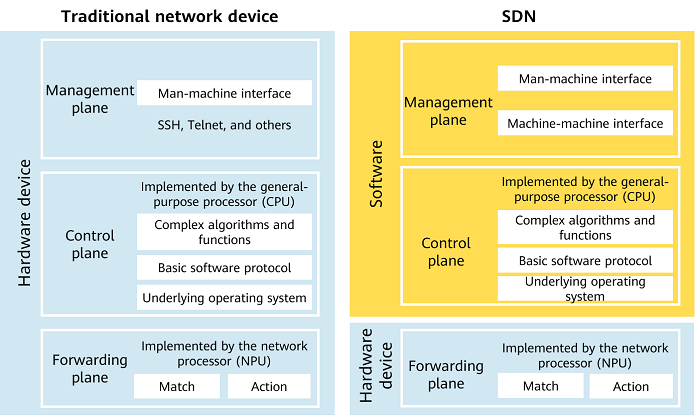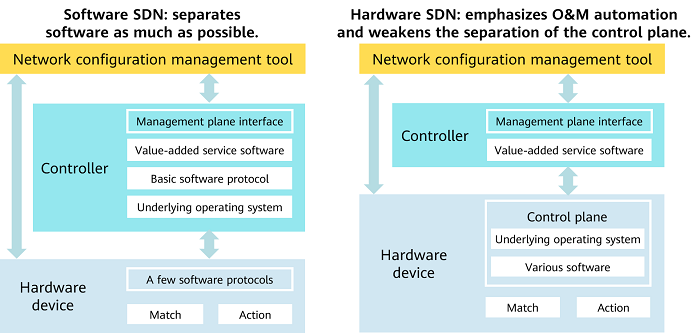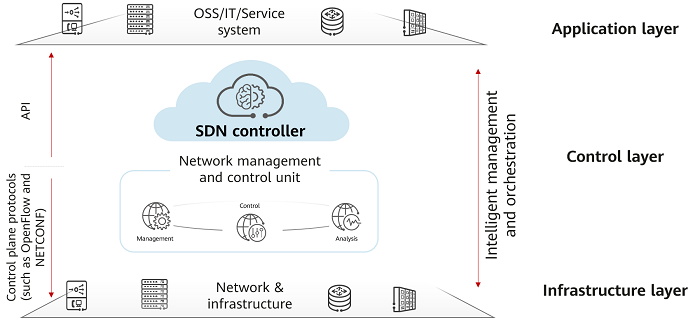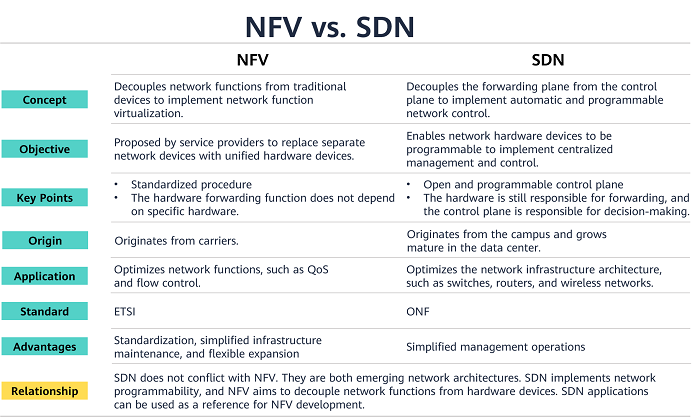What Is SDN?
Software-defined networking (SDN) is a network management method that supports dynamic programmable network configuration. As such, it improves network performance and management efficiency, and enables network services to provide flexible customization capabilities like cloud computing. Decoupling the forwarding plane and control plane of network devices, SDN uses the controller for network device management, network service orchestration, and service traffic scheduling, which features low costs, centralized management, and flexible scheduling.
Why Do We Need SDN?
Limitations of Traditional Networks
On traditional distributed networks, reachability information is broadcast between devices at Layer 2, and topology information is transmitted through standard routing protocols at Layer 3. This requires that all devices, regardless of their vendors, use the same network protocol for successful communication. With the rapid development of services, users have ever-changing requirements on networks. Once a network fails to satisfy new requirements, protocol formulation and modification are required, resulting in slow upgrades of network devices.
To well adapt to varying requirements and scenarios, traditional networks are becoming more and more complex. A traditional network involves many protocols, which may result in inconsistencies between vendors due to unclear specifications.
On a traditional network, devices are managed one by one using commands, leading to low network management and service scheduling efficiency and high O&M costs.
SDN Technical Roadmap
To address the issues of slow development and high O&M costs of traditional networks, service providers began to explore new network architectures. They hoped to decouple the control plane (operating systems and software) from hardware and implement open-source development of underlying operating systems, basic software protocols, and value-added service software. This is where SDN technology comes in.
On a traditional network, network devices can be divided into the management plane, control plane, and forwarding plane.
Management plane: orchestrates services and formulates policies.
Control plane: controls operating system running and calculates using various algorithms.
Forwarding plane: forwards and receives data packets.
The concept of SDN is to decouple the control and forwarding functions of network devices so that the control plane of network devices can be directly programmed and network services can be abstracted from underlying hardware devices.
The following figure shows the comparison between the SDN architecture and the traditional network architecture.

Comparison between the traditional network architecture and SDN architecture
The classic SDN technical roadmap emphasizes the separation of the control plane, expecting that network devices can be changed to white-box devices to implement user-defined network functions.
However, in the SDN development process, due to factors such as complex underlying protocols and huge software development investment, vendors gradually shift their focus from separation of the control plane to O&M automation. Vendors propose that the operating system and most software are still deployed on hardware devices, the original network device form is retained, and the controller is used to interconnect with hardware devices and network configuration management tools to implement unified management and service orchestration of hardware devices on the management plane. The following figure shows the comparison between the two SDN technical roadmaps. The classic SDN technical roadmap is called software SDN, and the one that weakens separation of the control plane is called hardware SDN.

Comparison between software SDN and hardware SDN
SDN Architecture
The SDN architecture consists of the infrastructure layer, control layer, and application layer.
- Infrastructure layer: consists of forwarding devices, such as data center switches.
- Control layer: consists of SDN control software and communicates with forwarding devices through standard protocols to control the infrastructure layer.
- Application layer: typically houses OpenStack-based cloud platforms. Users can build their own cloud management platforms based on OpenStack.
SDN uses northbound and southbound application programming interfaces (APIs) to implement communication between layers. Northbound APIs are responsible for communication between the application layer and the control layer, and southbound APIs are responsible for communication between the infrastructure layer and the control layer.

SDN architecture
Advantages of SDN
In the current mainstream SDN architecture, the operating system and basic protocol functions on traditional hardware devices are retained, and the controller collects device information on the entire network, which has the following advantages:
- Network programmability
Network devices provide APIs so that development and management personnel can send instructions to network devices by using a programming language. Network engineers can use scripts to automatically create and assign tasks and collect network statistics. As such, CLI- and SNMP-based scripts can be converted to programmable objects and provides more functions.
- Network abstraction
As the middle layer, the controller interacts with network devices and applications through southbound and northbound APIs, respectively, and abstracts underlying hardware devices as virtualized resource pools. Applications and services are no longer tightly coupled with hardware.
- Cost reduction
The original hardware devices are retained on the network, and they still have all functions of management, control, and forwarding. This does not require large-scale migration, facilitating the reconstruction of the entire network. The introduction of controllers transforms manual configuration into machine-based configuration, improving O&M efficiency and reducing O&M costs.
- Flexible service scheduling
Traditional hardware devices cannot implement flexible load balancing on the network. The optimal routes are mostly responsible for the heaviest forwarding tasks. Even if QoS and flow control functions alleviate this problem, traffic scheduling still strongly depends on the configuration of a single device. As such, the use of traditional hardware devices can be regarded as an isolated and distributed management mode. Without changing the overall logic of hardware devices, SDN adds open northbound and southbound APIs to translate computer languages into configuration command lines, making GUI-based management and centralized management possible and solving the problem of inflexible service scheduling on traditional networks.
- Centralized management
Traditional network devices are managed in a distributed manner. A single network device cannot learn the status of the entire network. With controllers, network administrators can manage underlying hardware devices, orchestrate network services, allocate network resources, and adjust traffic priorities. They can directly detect the status of the entire network and adjust bandwidth and optimization policies in a timely manner, facilitating network-wide management.
- Openness
The SDN architecture allows vendors to develop their own ecosystems through open APIs. These open APIs support multiple applications, such as cloud orchestration, OSS/BSS, and SaaS. In addition, the SDN architecture can control hardware of multiple vendors through OpenFlow.
What Are the Differences Between SDN and NFV?
NFV is also a network architecture. It encapsulates network functions of traditional physical devices into independent modular software, which then runs on hardware devices to implement diversified network functions.
The similarities between SDN and NFV are as follows:
- They both aim to implement network virtualization and resource pooling of physical devices.
- They both improve network management and service orchestration efficiency.
- They both want to orchestrate networks through GUI operations or programming languages.
For the differences between SDN and NFV, see the following figure.

What are the differences between NFV and SDN?
The SDN abstracts physical network resources (such as switches and routers) and transfers decision making to the virtual network control plane. The control plane determines where to send traffic, and the hardware continues to guide and process the traffic, without relying on standard hardware devices. NFV aims to virtualize all physical network resources and allow networks to expand without adding more devices, which depends on standard hardware devices.
The classic SDN architecture originally aims to decouple hardware and software. However, due to factors such as software R&D costs and device replacement, the current SDN solution weakens the separation of the control plane and focuses only on automatic network O&M.
Future and Challenges of SDN
In the data center field, most large-scale data centers have adopted the flattened architecture, which brings great challenges to network device management. Automatic O&M and centralized management brought by SDN have great application space in automatic scheduling and capacity expansion of data centers.
In the video field, SDN supports real-time scheduling of data flows, enabling networks to carry more traffic.
In the field of machine learning and artificial intelligence (AI), SDN will also be influenced by operational requirements and software innovation to provide richer and more up-to-date network experience.
In the future autonomous driving network (ADN), the SDN architecture can also play an important role.
However, like other IT products, SDN has drawbacks such as lack of security, scalability, extensive cooperation, and ecosystem.
- Security risks incurred by centralized management
Centralized management, although convenient, also brings security risks. If a single node under centralized management is attacked, the entire network may be affected.
- Bottlenecks of SDN controllers
Software is separated from hardware in the SDN architecture, which poses great challenges to the software development and computing of controllers.
- Lack of unified standards for northbound APIs
The lack of standard northbound APIs leads to inconsistent interfaces provided by suppliers and increasing difficulties in application development. Developers responsible for an application must enable the application to interact with different controllers.
Huawei SDN Solutions
Currently, Huawei's solutions use iMaster-NCE to implement unified management and automatic O&M of network devices and provide network services that support automatic O&M for IT applications and cloud platforms. Huawei provides the CloudCampus solution for campus networks, the CloudFabric solution for data center networks (DCNs), and the SD-WAN solution for wireless networks.
CloudCampus solution: Based on the ADN concept and architecture, the Huawei CloudCampus solution uses technologies such as 5G, Wi-Fi 6, SDN, cloud, and intelligence to build campus networks that feature all-GE access, intelligent experience of one-hop-to-cloud, and unified management and new O&M. Such networks improve digital operation efficiency and comprehensively reduce the CAPEX and OPEX of campus networks.
CloudFabric solution: The Huawei CloudFabric solution is a DCN SDN solution. It uses Huawei CloudEngine series data center switches, iMaster NCE-Fabric (DCN controller), iMaster NCE-FabricInsight (intelligent network analysis platform), and HiSec (security solution) to provide customers with simplified operation experience covering the entire lifecycle of a DCN, including planning and construction, service provisioning, O&M monitoring, and change optimization. This solution can intelligently discover, analyze, and isolate faults. In addition, the Huawei CloudFabric solution can meet the all-Ethernet evolution requirements for data centers. It can integrate the computing network with the storage network to achieve zero packet loss on the Ethernet and improve computing and storage performance.
SD-WAN solution: Enterprise networks are facing issues such as closed WAN architecture, difficult service experience assurance, slow service deployment, and difficult O&M. To address these issues, the Huawei SD-WAN solution implements all-scenario interconnection between enterprise branches, between enterprise branches and data centers, and between enterprise branches and the cloud. This solution stands out with the application-based intelligent traffic steering and acceleration as well as intelligent O&M features to deliver better service experience and reshape the full-process service outcomes of enterprise WAN interconnections.
- Author: Li Yefan
- Updated on: 2021-09-30
- Views: 20820
- Average rating:







